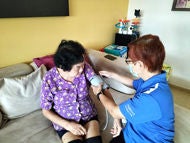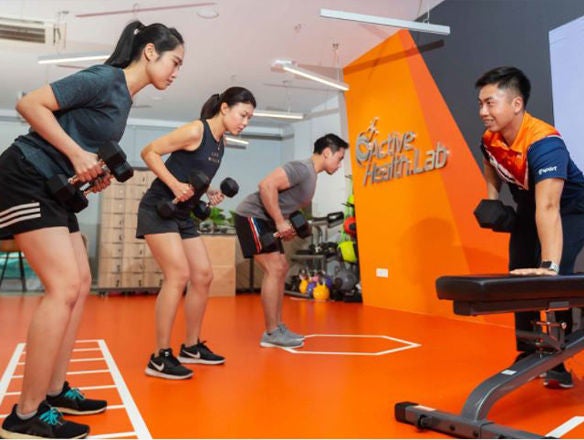3D-PRINTED CUSTOM INSOLES: ADVANCING DIABETIC FOOT CARE AT SENGKANG GENERAL HOSPITAL
SINGAPORE, 8 JULY 2025 – Sengkang General Hospital (SKH) has piloted an innovative approach to diabetic foot care through in-house production of 3D-printed custom insoles in a cross-institution collaboration with Singapore General Hospital's (SGH) 3D printing centre. Traditional pressure-relieving insoles, produced overseas, typically take up to two months to reach patients, with extended time needed for adjustments as it may involve shipping the insoles back and forth sometimes. Now, patients can receive precisely customised insoles in just one week - marking a significant advancement in both accessibility and quality of care for patients with diabetes.
In Singapore, diabetes affects over 400,000 people, with one in three Singaporeans facing a lifetime risk of developing the condition. If current trends continue, this number could reach one million by 2050.1 Studies show that 15-25% of patients with diabetes develop foot ulcers, with over 80% of lower limb amputations originating from these ulcers.2,3
This innovation transforms SKH’s diabetic foot care from a manual craft into a precise science. Traditional insoles are created by hand or with the aid of CNC machines, using materials like EVA foam or other suitable materials. This manual process not only takes longer but can lead to variations in quality and fit. Any adjustments needed may mean shipping the insoles back overseas, further extending waiting times.
In contrast, SKH's new approach involves digitally scanning the foam box impressions before designing each insole with varying densities and precise topographical adjustments for different areas of the foot using specialised software. The subsequent in-house 3D printing ensures these exact specifications are manufactured with consistent quality. The digital workflow allows for quick modifications when needed, ensuring optimal fit without the delays of international shipping. This end-to-end process not only delivers superior precision but also enhances operational efficiency, making customised care more affordable and accessible.
For patients with diabetes, especially those with reduced sensation in their feet due to nerve damage (diabetic neuropathy), customised pressure-relieving insoles are essential in preventing new ulcers and supporting wound healing. This is even more critical in patients who have undergone soft tissue reconstruction, where altered foot anatomy presents additional challenges.
The SKH Podiatry team spearheaded this multi-disciplinary innovation with the Department of Orthopaedic Surgery and Plastic, Reconstructive & Aesthetic Surgery Services teams under the SKH Diabetic Limb Salvage (DLS) service, as well as SGH’s 3D printing centre. This initiative combines their distinct expertise, demonstrating how cross-institution partnerships and innovative mindsets can transform healthcare delivery.
The podiatry team conducted comprehensive patient assessments, using detailed biomechanical examination and pressure mapping analysis to design precise digital models for each patient’s insoles. The Orthopaedic Surgery team played a crucial role in optimising the printing parameters, material selection, and creating various prototypes. The Plastic, Reconstructive & Aesthetic Surgery team complemented these efforts by bringing their expertise in wound healing and tissue reconstruction, ensuring the insoles would work in harmony with surgical interventions and support optimal healing conditions.
Mr Alvis Leon Timothy Charles, Head, Department of Podiatry, SKH, explains: "Each insole is intricately designed by our podiatrists using specialised software that allows us to customise the material density and topographical contours (surface shapes) in every area. The outcome is a uniquely crafted product which matches each patient's specific foot structure and pressure points - something we have not been able to achieve with such precision before. This precision is critical in both wound recovery and ulcer prevention."
"The advancement in 3D printing technology has opened new possibilities in patient care," says Dr Dickson Chau, Consultant, Department of Orthopaedic Surgery, SKH. "Through extensive testing of different materials and printing parameters, and valuable knowledge-sharing with SGH's established 3D printing facility, we have developed a robust manufacturing process that ensures consistent quality of these insoles. This in-house production capability allows us to quickly refine the insoles based on patient feedback, which is important for optimal outcomes.”
Initial results show that SKH's custom 3D-printed insoles can reduce peak pressure by up to 28.5% and improve pressure distribution by 52.7%, compared to 23% reduction and 40% improved distribution with traditional insoles.
The impact is evident in patients like Mr Wong Sia Woon, 53, who had foot ulcers that resulted in three toe amputations in recent years. With the new insoles specially shaped to fill in the gaps and provide better foot support, he can now walk comfortably for longer periods. This has greatly improved his daily life, and the faster access to these insoles has enabled him to start his recovery earlier.
"With Singapore facing one of the highest amputation rates in the developed world4,5, early intervention is crucial," says Dr Feng Jiajun, Consultant, Plastic, Reconstructive and Aesthetic Surgery Services, SKH. "Our team has seen how delayed treatment can lead to devastating outcomes. This innovation represents a significant shift towards preventive care. By detecting pressure points early and providing precisely customised solutions, we can potentially reduce ulcer formation and lower amputation risks. The ability to produce these insoles in-house has transformed our approach to diabetic foot care."
The innovation brings multiple benefits: faster access to customised care, enhanced pressure distribution for better wound healing and ulcer prevention, improved patient mobility, and supports environmental sustainability through the use of recyclable materials in local production.
The SKH podiatry team is currently conducting a comprehensive research study to further validate these initial results, with plans to expand the programme beyond diabetic care.
###
References:
1 https://www.moh.gov.sg/newsroom/diabetes-the-war-continues
2 Armstrong DG, Boulton AJM, Bus SA. Diabetic Foot Ulcers and Their Recurrence. N Engl J Med. 2017 Jun 15;376(24):2367-2375. doi: 10.1056/NEJMra1615439. PMID: 28614678.
3 Peng X, Gou D, Zhang L, Wu H, Chen Y, Shao X, Li L, Tao M. Status and influencing factors of lower limb amputation in patients with diabetic foot ulcer. Int Wound J. 2023 Jan 18;20(6):2075-2081. doi: 10.1111/iwj.14076.
4 https://www.moh.gov.sg/newsroom/speech-by-mdm-rahayu-mahzam-senior-parliamentary-secretary-ministry-of-health-ministry-of-law-at-the-diabetes-singapore-walk-again-with-confidence-2023-8-april-2023-145pm-at-lifelong-learning-institute
5 Riandini T, Pang D, Toh MPHS, Tan CS, Choong AMTL, Lo ZJ, Chandrasekar S, Tai ES, Tan KB, Venkataraman K. National Rates of Lower Extremity Amputation in People With and Without Diabetes in a Multi-Ethnic Asian Population: a Ten Year Study in Singapore. Eur J Vasc Endovasc Surg. 2022 Jan;63(1):147-155. doi: 10.1016/j.ejvs.2021.09.041.



















